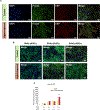Light-induced generation and toxicity of docosahexaenoate-derived oxidation products in retinal pigmented epithelial cells
- PMID: 30296412
- PMCID: PMC6443467
- DOI: 10.1016/j.exer.2018.09.012
Light-induced generation and toxicity of docosahexaenoate-derived oxidation products in retinal pigmented epithelial cells
Abstract
Oxidative cleavage of docosahexaenoate (DHA) in retinal pigmented epithelial (RPE) cells produces 4-hydroxy-7-oxohept-5-enoic acid (HOHA) esters of 2-lysophosphatidylcholine (PC). HOHA-PC spontaneously releases a membrane-permeant HOHA lactone that modifies primary amino groups of proteins and ethanolamine phospholipids to produce 2-(ω-carboxyethyl)pyrrole (CEP) derivatives. CEPs have significant pathological relevance to age-related macular degeneration (AMD) including activation of CEP-specific T-cells leading to inflammatory M1 polarization of macrophages in the retina involved in "dry AMD" and TLR2-dependent induction of angiogenesis that characterizes "wet AMD". RPE cells accumulate DHA from shed rod photoreceptor outer segments through phagocytosis and from plasma lipoproteins secreted by the liver through active uptake from the choriocapillaris. As a cell model of light-induced oxidative damage of DHA phospholipids in RPE cells, ARPE-19 cells were supplemented with DHA, with or without the lipofuscin fluorophore A2E. In this model, light exposure, in the absence of A2E, promoted the generation HOHA lactone-glutathione (GSH) adducts, depletion of intracellular GSH and a competing generation of CEPs. While DHA-rich RPE cells exhibit an inherent proclivity toward light-induced oxidative damage, photosensitization by A2E nearly doubled the amount of lipid oxidation and expanded the spectral range of photosensitivity to longer wavelengths. Exposure of ARPE-19 cells to 1 μM HOHA lactone for 24 h induced massive (50%) loss of lysosomal membrane integrity and caused loss of mitochondrial membrane potential. Using senescence-associated β-galactosidase (SA β-gal) staining that detects lysosomal β-galactosidase, we determined that exposure to HOHA lactone induces senescence in ARPE-19 cells. The present study shows that products of light-induced oxidative damage of DHA phospholipids in the absence of A2E can lead to RPE cell dysfunction. Therefore, their toxicity may be especially important in the early stages of AMD before RPE cells accumulate lipofuscin fluorophores.
Keywords: A2E; Age-related macular degeneration; Carboxyethylpyrrole; Lipid oxidation; Lysosome; Mitochondrial membrane potential.
Copyright © 2018 Elsevier Ltd. All rights reserved.
Figures

















Similar articles
-
4-Hydroxy-7-oxo-5-heptenoic acid (HOHA) lactone induces apoptosis in retinal pigment epithelial cells.Free Radic Biol Med. 2020 May 20;152:280-294. doi: 10.1016/j.freeradbiomed.2020.03.017. Epub 2020 Mar 25. Free Radic Biol Med. 2020. PMID: 32222470 Free PMC article.
-
4-Hydroxy-7-oxo-5-heptenoic Acid (HOHA) Lactone is a Biologically Active Precursor for the Generation of 2-(ω-Carboxyethyl)pyrrole (CEP) Derivatives of Proteins and Ethanolamine Phospholipids.Chem Res Toxicol. 2015 May 18;28(5):967-77. doi: 10.1021/acs.chemrestox.5b00001. Epub 2015 Apr 2. Chem Res Toxicol. 2015. PMID: 25793308 Free PMC article.
-
4-Hydroxy-7-oxo-5-heptenoic Acid Lactone Is a Potent Inducer of the Complement Pathway in Human Retinal Pigmented Epithelial Cells.Chem Res Toxicol. 2018 Aug 20;31(8):666-679. doi: 10.1021/acs.chemrestox.8b00028. Epub 2018 Jul 9. Chem Res Toxicol. 2018. PMID: 29883119 Free PMC article.
-
Oxidative stress, polyunsaturated fatty acids-derived oxidation products and bisretinoids as potential inducers of CNS diseases: focus on age-related macular degeneration.Pharmacol Rep. 2013;65(2):288-304. doi: 10.1016/s1734-1140(13)71005-3. Pharmacol Rep. 2013. PMID: 23744414 Review.
-
Heat shock proteins as gatekeepers of proteolytic pathways-Implications for age-related macular degeneration (AMD).Ageing Res Rev. 2009 Apr;8(2):128-39. doi: 10.1016/j.arr.2009.01.001. Ageing Res Rev. 2009. PMID: 19274853 Review.
Cited by
-
AUTOPHAGY IN THE EYE: FROM PHYSIOLOGY TO PATHOPHYSOLOGY.Autophagy Rep. 2023;2(1):2178996. doi: 10.1080/27694127.2023.2178996. Epub 2023 Mar 1. Autophagy Rep. 2023. PMID: 37034386 Free PMC article.
-
LXA4 protects against blue-light induced retinal degeneration in human A2E-laden RPE cells and Balb-c mice.Ann Transl Med. 2021 Aug;9(15):1249. doi: 10.21037/atm-21-3390. Ann Transl Med. 2021. PMID: 34532386 Free PMC article.
-
Oxidative stress induces lysosomal membrane permeabilization and ceramide accumulation in retinal pigment epithelial cells.Dis Model Mech. 2023 Jul 1;16(7):dmm050066. doi: 10.1242/dmm.050066. Epub 2023 Jul 25. Dis Model Mech. 2023. PMID: 37401371 Free PMC article.
-
Frequency cumulative effect of subthreshold energy laser-activated remote phosphors irradiation on visual function in guinea pigs.Int J Ophthalmol. 2022 Feb 18;15(2):213-220. doi: 10.18240/ijo.2022.02.04. eCollection 2022. Int J Ophthalmol. 2022. PMID: 35186679 Free PMC article.
-
Oxidized LDL, homocysteine, homocysteine thiolactone and advanced glycation end products act as pro-oxidant metabolites inducing cytokine release, macrophage infiltration and pro-angiogenic effect in ARPE-19 cells.PLoS One. 2019 May 14;14(5):e0216899. doi: 10.1371/journal.pone.0216899. eCollection 2019. PLoS One. 2019. PMID: 31086404 Free PMC article.
References
-
- Alary J, Fernandez Y, Debrauwer L, Perdu E, Gueraud F, 2003. Identification of intermediate pathways of 4-hydroxynonenal metabolism in the rat. Chem Res Toxicol 16, 320–327. - PubMed
-
- Anoopkumar-Dukie S, Carey JB, Conere T, O’Sullivan E, van Pelt FN, Allshire A, 2005. Resazurin assay of radiation response in cultured cells. Br J Radiol 78, 945–947. - PubMed
-
- Artigas JM, Felipe A, Navea A, Fandino A, Artigas C, 2012. Spectral transmission of the human crystalline lens in adult and elderly persons: color and total transmission of visible light. Invest Ophthalmol Vis Sci 53, 4076–4084. - PubMed
Publication types
MeSH terms
Substances
Grants and funding
LinkOut - more resources
Full Text Sources
Medical
Research Materials

